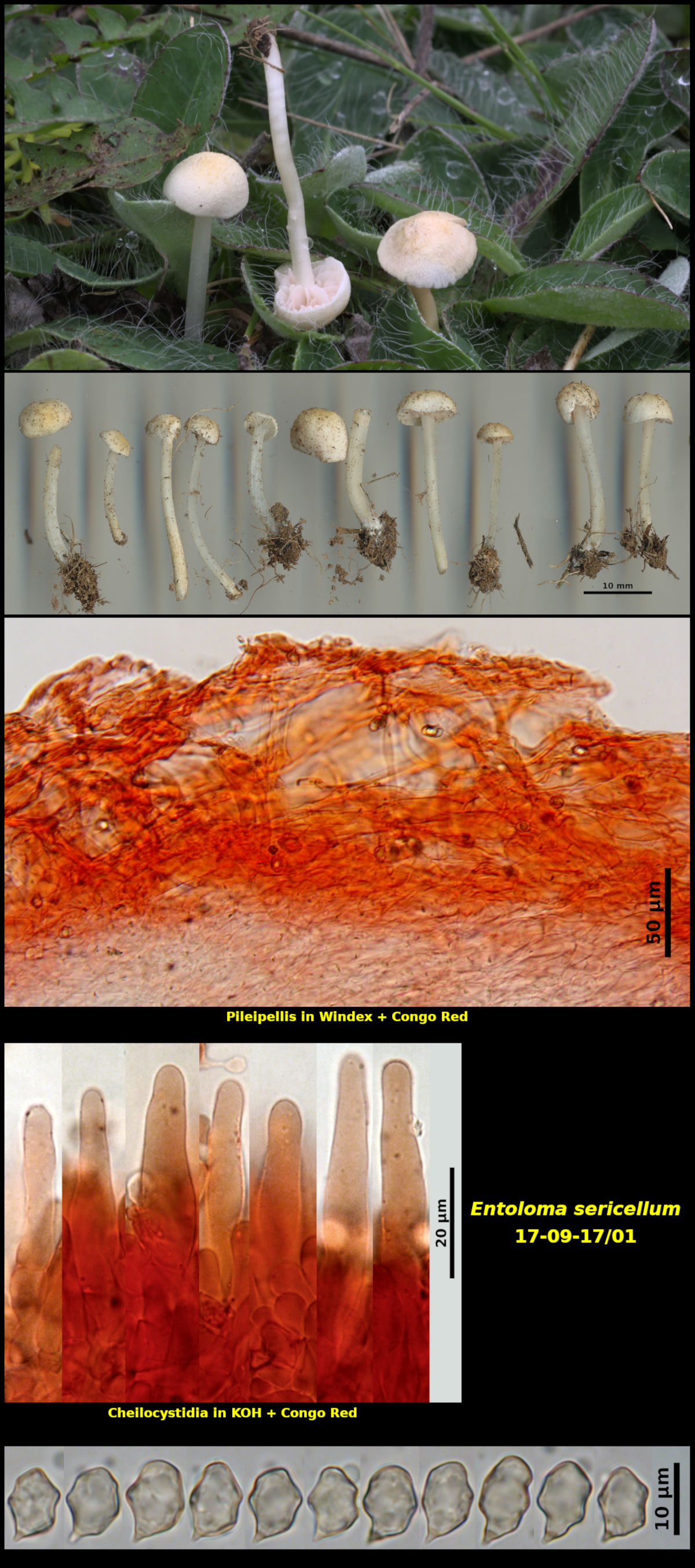Fleshy Fungi of New Brunswick >>
Entoloma sericellum
Entoloma sericellum (Fr.) P. Kumm.

Gregarious to scattered among plants of Hieracium sp. in dry rural lawn, Little Lepreau, New Brunswick (17-09-17/01).
Pileus convex-hemispherical at first, expanding to more broadly so at maturity, without an umbo, dry, silky-fibrillose, nearly white to very pale orange yellow (HSV40:05-10:100), 5-11 mm in diameter. Stipe equal, brittle, similar in colour to the pileus, densely pruinose at the apex and becoming less densely so toward the base, dry, 20-33 X 1.0-2.5 mm. Lamellae white at first, becoming pink as the spores mature, subclose, adnate to short-decurrent, not marginate but sometimes appearing slightly fringed. Flesh white in both pileus and stipe, lacking a distinctive odour and taste.
Basidiospores pinkish yellow in spore print, distinctly angular, heterodiametrical, 9.2-11.5 x 6.9-8.4 μm, Q = 1.24-1.53 (average[43]: 10.0 x 7.4 μm, Q = 1.36). Cheilocystidia scattered along the margins of the lamellae, cyclindrical to ventricose, occasionally sublageniform, thin-walled, with a basal clamp connection, 44-61 x 6.1-12.0 &mu:m. Basidia clavate, 4-spored, with a basal clamp connection. Pileipellis a thick interwoven trichodermium of broad cells with cytoplasmic pigment. Clamp connections present on most septa.
Easily recognized by its pinkish spore print, white pileus and stipe, adnate to short-decurrent lamellae and silky-fibrillose pileus. Microscopically it is characterized by its thick pileipellis of inflated and interwoven hyphae, scattered cheilocystidia and presence of clamp connections on nearly all septa.
Eccilia nivea, a very similar species described by Peck, was transferred by Largent and Benedict (Mycologia 62: 437-452. 1970) to Alboleptonia as A. sericella var. nivia, but it is still unclear how to deal with that taxon. Hesler (Brittonia 15: 324-366. 1963) examined Peck's type and stated it lacked both cheilocystidia and clamp connections, which clearly distinguishes it from E. sericellum. However, Largent and Benedict also examined the type specimen and found both cheilocystidia and clamp connections to be present. Noordeloos (Österr. Z. Pilzk. 17:87-152. 2008), hoping to clarify the issue attempted to examine the type and found the box empty! Apparently the type is now lost.
Although usually described as having a pure white pileus, Collection 17-09-17/01 has some yellowish tints. Elias Fries (Icones Selectae Hymenomycetum 1: 106. 1867) recognized this variation as Agaricus sercellus var. lutescens.
Photograph: D. Malloch (17-09-17/01).